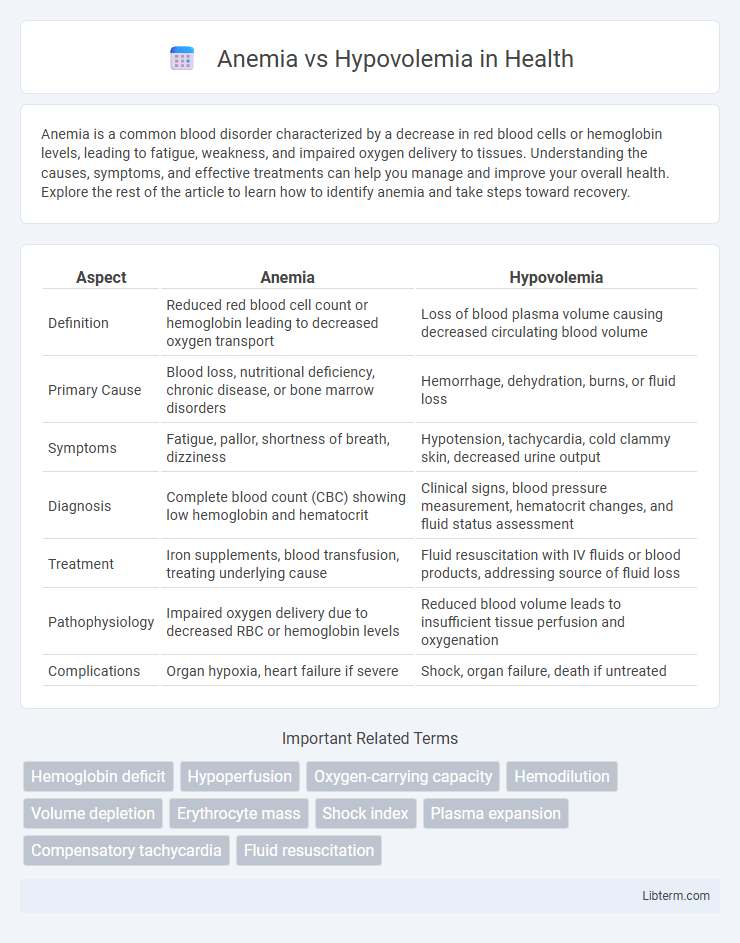Anemia is a common blood disorder characterized by a decrease in red blood cells or hemoglobin levels, leading to fatigue, weakness, and impaired oxygen delivery to tissues. Understanding the causes, symptoms, and effective treatments can help you manage and improve your overall health. Explore the rest of the article to learn how to identify anemia and take steps toward recovery.
Table of Comparison
| Aspect | Anemia | Hypovolemia |
|---|---|---|
| Definition | Reduced red blood cell count or hemoglobin leading to decreased oxygen transport | Loss of blood plasma volume causing decreased circulating blood volume |
| Primary Cause | Blood loss, nutritional deficiency, chronic disease, or bone marrow disorders | Hemorrhage, dehydration, burns, or fluid loss |
| Symptoms | Fatigue, pallor, shortness of breath, dizziness | Hypotension, tachycardia, cold clammy skin, decreased urine output |
| Diagnosis | Complete blood count (CBC) showing low hemoglobin and hematocrit | Clinical signs, blood pressure measurement, hematocrit changes, and fluid status assessment |
| Treatment | Iron supplements, blood transfusion, treating underlying cause | Fluid resuscitation with IV fluids or blood products, addressing source of fluid loss |
| Pathophysiology | Impaired oxygen delivery due to decreased RBC or hemoglobin levels | Reduced blood volume leads to insufficient tissue perfusion and oxygenation |
| Complications | Organ hypoxia, heart failure if severe | Shock, organ failure, death if untreated |
Understanding Anemia: Definition and Causes
Anemia is a condition characterized by a decrease in red blood cell count or hemoglobin concentration, leading to reduced oxygen delivery to tissues. Common causes include nutritional deficiencies such as iron, vitamin B12, or folate, chronic diseases, bone marrow disorders, and acute or chronic blood loss. Understanding these underlying factors is crucial for accurate diagnosis and effective treatment.
What is Hypovolemia? Key Concepts
Hypovolemia is a condition characterized by a significant decrease in blood plasma volume, often caused by hemorrhage, dehydration, or fluid loss from burns. Key concepts include reduced circulating blood volume, resulting in impaired tissue perfusion and potential shock if untreated. Unlike anemia, which involves low red blood cell count or hemoglobin, hypovolemia specifically pertains to fluid volume deficits impacting cardiovascular stability.
Pathophysiological Differences Between Anemia and Hypovolemia
Anemia is characterized by a reduction in red blood cell mass or hemoglobin concentration, leading to decreased oxygen-carrying capacity and tissue hypoxia, while hypovolemia involves a significant loss of intravascular volume resulting in decreased preload and cardiac output. The primary pathophysiological difference lies in anemia's impact on oxygen delivery due to impaired erythrocyte function versus hypovolemia's effect on circulatory volume homeostasis and blood pressure regulation. Both conditions trigger compensatory mechanisms like tachycardia and vasoconstriction, but anemia primarily stimulates erythropoiesis, whereas hypovolemia activates the renin-angiotensin-aldosterone system to restore fluid balance.
Common Symptoms: Anemia vs Hypovolemia
Anemia commonly presents with symptoms such as fatigue, pallor, and shortness of breath due to reduced oxygen-carrying capacity of the blood. Hypovolemia is characterized by symptoms including rapid heartbeat, low blood pressure, and dizziness resulting from decreased blood volume. Both conditions may cause weakness and confusion, but anemia primarily affects oxygen delivery, while hypovolemia impacts circulatory volume and perfusion.
Diagnostic Approaches for Anemia and Hypovolemia
Diagnostic approaches for anemia primarily involve complete blood count (CBC) to assess hemoglobin levels, hematocrit, and red blood cell indices, along with reticulocyte count to evaluate bone marrow response. Iron studies, vitamin B12, folate levels, and peripheral blood smear analysis aid in identifying the underlying cause of anemia. Hypovolemia diagnosis relies on clinical assessment including blood pressure, heart rate, capillary refill, and laboratory tests such as serum lactate, blood urea nitrogen (BUN) to creatinine ratio, and point-of-care ultrasound to evaluate intravascular volume status.
Major Risk Factors and Patient Populations
Anemia primarily affects patients with chronic kidney disease, nutritional deficiencies, or chronic inflammatory conditions, increasing their risk due to impaired red blood cell production or loss. Hypovolemia commonly occurs in trauma patients, those with severe dehydration, or massive hemorrhage, posing significant risk from acute volume depletion and hemodynamic instability. Both conditions require prompt identification in vulnerable populations such as elderly patients and those with cardiovascular comorbidities to prevent severe complications.
Treatment Strategies: Anemia Compared to Hypovolemia
Treatment strategies for anemia primarily involve addressing the underlying cause, such as iron supplementation for iron-deficiency anemia or erythropoiesis-stimulating agents for chronic disease anemia. Hypovolemia treatment focuses on rapid volume resuscitation using intravenous fluids like crystalloids or blood transfusions to restore circulating blood volume. While anemia management targets improving oxygen-carrying capacity through hematologic interventions, hypovolemia therapy concentrates on restoring intravascular volume to stabilize hemodynamics and prevent shock.
Laboratory Findings: Distinguishing the Two Conditions
Laboratory findings in anemia reveal decreased hemoglobin concentration and hematocrit levels due to reduced red blood cell mass, while hypovolemia typically presents with normal hemoglobin and hematocrit values initially but shows increased blood urea nitrogen (BUN) to creatinine ratio and elevated serum lactate from hypoperfusion. In anemia, reticulocyte count may be elevated in regenerative types, whereas hypovolemia does not alter reticulocyte counts. Electrolyte imbalances and acid-base disturbances are more pronounced in hypovolemia, reflecting volume loss and tissue hypoxia.
Potential Complications and Prognosis
Anemia can lead to complications such as severe fatigue, heart failure, and impaired oxygen delivery to tissues, which may result in organ damage if untreated. Hypovolemia carries a high risk of shock, acute kidney injury, and multi-organ failure due to insufficient blood volume and oxygen perfusion. Prognosis for anemia improves with appropriate treatment like supplementation or transfusion, whereas hypovolemia prognosis depends on rapid volume resuscitation and addressing the underlying cause to prevent fatal outcomes.
Prevention and Patient Education
Anemia prevention centers on balanced nutrition with adequate iron, vitamin B12, and folate intake, alongside managing chronic conditions and avoiding blood loss. Hypovolemia prevention involves maintaining proper hydration, recognizing early signs of fluid loss, and managing underlying causes such as bleeding or severe infections. Educating patients about symptom recognition, timely medical consultation, and adherence to treatment plans is crucial for preventing complications associated with both anemia and hypovolemia.
Anemia Infographic

 libterm.com
libterm.com